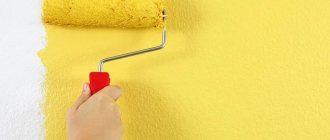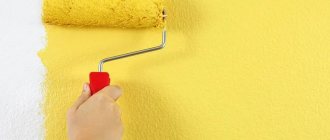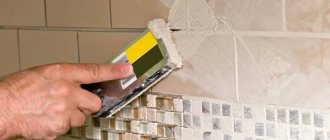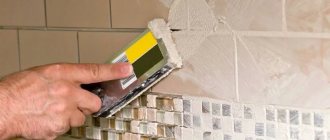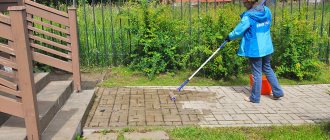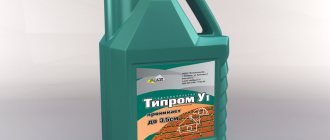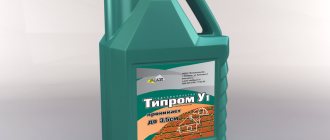Well, if you decide to make tiles with your own hands, then to give them the desired color shade, you just need to add a coloring pigment of the desired color to the cement mixture. In this case, to achieve a suitable shade, it will be possible to make several test batches, recording the exact proportions that showed the result closest to the goal.
Well, what to do if these paths have long been laid out with simple paving material of a dull gray color? Then, oddly enough, you should just paint it the color you like. To do this, you should know how to paint paving slabs, and what is the technology for performing such work.
Advantages and disadvantages of coloring
Before purchasing the necessary materials and starting work, it is advisable to understand the advantages and disadvantages of this method of updating paths. This, at first glance, simple technology requires the utmost attention from the performer when performing it, because any deviation can lead to the fact that after 2-3 years the paint coating can come off and it will be much more difficult to correct the situation.
The positive qualities of surface paint applied to paving stones are:
- the appearance of the sidewalk or paved area is radically transformed, changing the entire landscape design for the better;
- the layer not only gives the surface a beautiful appearance, but also provides good protection from harmful atmospheric and mechanical influences;
- slipping is reduced in the cold season and after rain in summer;
- special paints, together with pre-treatment, increase the service life of the tile itself.
In addition to its positive qualities, this method also has serious disadvantages:
- the need for periodic repainting of the surface, which can be repeated every 8-12 years;
- the complexity of carrying out work that will take at least several days;
- danger of poisoning from toxic fumes during work.
To avoid poisoning, painting paving slabs is carried out wearing a respiratory mask, periodically taking a break for an hour and a half.
Preparing for painting
Painting paving slabs begins with careful preparation of its surface. The quality of the work very much depends on how well it was prepared for applying paint. Read the instructions for use of the dye carefully. There may be additional requirements. All of them are required.
After you have cleared the tiles of dirt and swept up all the debris and dust, you need to rinse the pavers with water from a hose.
Preparation begins with clearing away debris, dust and dirt. If it is possible to use a powerful vacuum cleaner, this will give very good results, but an ordinary household vacuum cleaner will not cope with such work.
In general, this will allow the surface to be prepared to be completely cleaned. Wait until the tiles are completely dry, because paint cannot be applied to a wet surface.
To improve the mechanical properties of concrete and increase adhesion, it is recommended to prime the cleaned tiles with an acid mordant solution. It penetrates deep enough into the concrete, making the surface more porous, which will allow the paint to penetrate into the material, strengthen it more strongly and provide better adhesion to the surface.
Paints used
Rubber, alkyd or polyurethane paints are used to paint paving surfaces. Each dye for paving slabs is characterized by increased wear resistance and is slightly susceptible to atmospheric influences. If you could not find ready-made paint of the desired shade, then you can add a light coloring pigment and achieve the desired result.
To improve the adhesion and strength properties of concrete, it is recommended to use acid mordants as a primer when preparing the surface.
Acid solutions themselves are not capable of coloring the surface, but work well as a base.
Types of dyes
Having answered the question whether it is possible to paint paving slabs on the street, you need to choose what composition to paint the paving stones with:
- Rubber is a product based on acrylic. Products painted with this composition do not slip, are resistant to wear, can withstand different temperatures, do not peel, do not crack, and are waterproof.
- Acid – intended for concrete coating.
- Alkyd is a persistent dye that can withstand any atmospheric conditions. Increases resistance to chemical attack, protects against damage, and prevents the appearance of salt stains.
- Polyurethane is durable, resistant to damage and shock, but fades over time and requires updating, while the protective functions remain. Seals and seals tiles.
All compositions suitable for painting are wear-resistant and protect the surface, but what is the best way to paint a tile floor? You can choose a product based on popularity of use - the highest indicator is for rubber paint.
Recommendations before starting work
Since painting of paving slabs in most cases is done outdoors, weather conditions should be taken into account when carrying out the work. Therefore, before painting paving slabs, be sure to look at the weather report for at least the next week.
To carry out the work, dry, windless weather with a temperature above +10°C is required. Application of polyurethane paints is also allowed at subzero temperatures. Therefore, carefully read the instructions for the coloring agent.
The requirement for calm weather occurs because wind will interfere with surface cleaning by sweeping up dust and debris. And if dust and debris fly onto a freshly painted surface, the result will be completely sad.
It is necessary to select several days during which the weather will be close to ideal, and it is not at all so easy to guess. You can organize gradual painting in small areas. Then the work site can be covered with a canopy in case of rain or protected from the wind with a shield. Divide the entire yard into small sectors and carry out work in each of them separately. But, this method, of course, will drag out the whole process for a very long time.
Coloring in the mass during production
Not every color on the counter of a hardware store can be added to concrete. You can find out whether it is possible to use pigment when mixing structural material for paving slabs, taking into account the following nuances:
- It is prohibited to contain zinc, lead, other heavy metals and their salts in the color, as they sharply reduce the adhesion of cement stone;
- Only UV-resistant and alkali-inert dyes should be used;
- pigments can absorb up to ¼ of the volume of liquid from concrete, disrupting the hydration process;
- The covering power of the pigment increases as its fineness decreases.
Important! Without reducing the strength of concrete, the bright color of the tile is ensured by introducing no more than 5% of the mass of cement into its composition of pigment.
Organic-based pigments are not suitable for concrete; mineral dyes (metal oxides) are used. The most commonly used pigments are brown, yellow and reddish shades (iron oxide), less often white (titanium oxide), purple, blue, green and other dyes are rarely used and are more expensive.
Pigments for concrete based on metal oxides.
We wrote about how tiles are made at home here.
Double-layer FEM elements
The main problem in the manufacture of colored FEM elements is the sharp increase in cost when dyeing in bulk. Therefore, the technology of two-layer paving slabs is used:
- not all the concrete is mixed with the pigment, but 1/3 of the total volume of the batch;
- the form is filled one third with the color mixture, which is distributed inside it on a vibrating table for 20 seconds;
- then the form is filled to the top with ordinary gray concrete;
- after 40 seconds of vibration, the form is removed for drying or stripping.
Double-layer paving slabs.
Advice! Depending on what kind of concrete is used for paving stones, the product will be painted entirely or in spots, since the dye is not able to saturate the crushed stone. Therefore, for paving slabs, sand concrete without coarse aggregate or a CPS mixture in a proportion of 1/3 is more often used, respectively.
Coloring paving slabs
Paint is applied to concrete with a paint roller or a wide, comfortable brush in 2-3 layers. Moreover, each subsequent layer is applied only after the previous one has completely dried. The period for complete drying is usually indicated in the instructions for use.
If you are using rubber or alkyd paint, then for better penetration into the material, it is recommended to add a little 20% mineral turpentine. Turpentine is not added to the paint for the second and third layers.
When using a roller, it is very convenient to use a special painting tray.
If you are painting a large area, be sure to constantly stir the paint solution to ensure a consistently even color. Using a spray gun to apply paint is not possible because you have to press or rub the paint into the surface with your hand. The spray gun does not provide this.
Price
There are many types of coloring mixtures available in the market. On sale you can find pigments for concrete from domestic and foreign manufacturers. Buyers can buy paint of a certain color and in the right quantity without much difficulty. But the price for such goods is different. The cost of dyes depends on several factors:
- Manufacturer.
- Type and color of color.
- Pigment weights.
You can buy inexpensive but high-quality pigments or purchase expensive but proven dyes.
After completion of work
Even after the paint surface becomes dry to the touch, you should not walk on it for several days. The fact is that only the top layer (for example, the third) has finally dried out. But it slows down the final drying of the lower layers. This point must be taken into account when planning work, so that it does not turn out that you cannot enter the house without damaging the fresh paint coating.
Be sure to save one empty paint can or its label. After 5-8 years you will have to tint the tiles, and you can easily choose a material to renew the surface. If you used pigment to change shades, then save information about it.
It is possible to achieve a high-quality and beautiful surface of paths and areas paved with paving slabs, regardless of its shape and past service life. As a result, you can update the overall landscape design of the site and provide good additional protection for the material.
The best choice is acrylic-based paint
A pattern that is highlighted with paint.
The dyes contain acrylic polymer, which makes the material durable and wear-resistant. The positive aspects of use include:
- elasticity;
- fire safety;
- wear resistance;
- resistance to atmospheric conditions.
In addition to these points, rubber paint has aesthetic qualities:
- Rubber paint for paving stones has a wide variety of shades, so choosing the right color is not difficult.
- The product is applied evenly, resulting in a beautiful surface. If the tile is porous, a smooth effect is achieved by applying a double layer of paint. To improve the appearance, the tiles are pre-coated with a primer.
- After drying, the surface of the paving surface becomes bright and shiny, as a protective film is formed. This film has maximum hygroscopicity and anti-salt properties, which extends its service life.
The protective layer does not allow mold, fungi, and other microorganisms to develop.
Attention! Rubber paint, in addition to its positive qualities, is considered economical - only 5 liters of rubber paint are enough to paint 20 m of paths and curbs.
How can you paint street coverings?
Sometimes there is a desire to change the appearance of the tile covering. How to decorate the masonry if the path in the yard is already laid with standard gray slabs? You can transform plain tilework by painting its individual elements. How to paint paving slabs? For this type of painting, paints based on polyurethane, rubber or alkyd resins are suitable. Each of them has its own characteristics:
- polyurethane paint for concrete based on polyester resins (odorless, durable, forms a protective film on the surface);
- enamel based on alkyd resins (good adhesion, high durability, quick drying, disadvantages include a strong odor during operation);
- dye based on liquid rubber (non-toxic, pigments are resistant to temperature changes and ultraviolet rays, do not fade).
How to clean tiles or paving stones?
Tiled spaces will look neat only with regular maintenance; even completely new tiles need to be cleaned of cement that has adhered during laying work. As the tiles are used, contaminants of various origins accumulate on them. This could be spilled car oil, efflorescence, ingrown moss, or dirt and dust.
The resulting stains spoil the beauty of the tiles, giving them a sloppy appearance. Timely cleaning helps remove absorbed dirt and extend the life of the coating. Each type of stain has its own optimal product and method of working with it.
Paving slabs are a good decorative element for a garden plot or country estate. If you play with such a solution correctly, you can end up with a unique work of art that you can create with your own hands. To properly paint a walkway, you need to know some rules.
How to work with acid paints - step by step diagram
Step 1: Surface Preparation
If you are painting a fresh concrete surface, it must be thoroughly dry and hardened. At least three weeks should pass between pouring the concrete and painting it using this method. Before painting, it doesn’t hurt to wash off any excess lime milk that has hardened on the surface with water. Old surfaces made of concrete or paving slabs need to be washed much more thoroughly - any dirt will interfere with the chemical reaction.
The older the surface, the harsher the cleaning must be in this case - you may even need to use a wire brush to remove the top layer of concrete. After such cleaning, do not forget to wash off the resulting dust.
Step 2: Apply “acid”
The first method of applying a paint composition is to simply fill the surface, which gives a particularly rich color. However, material consumption also increases. Working with a spray gun consumes less dye, and you can apply it in several layers or divide the surface to be painted into different color sectors.
When painting, you can achieve a chaotic pattern using ordinary sawdust - the liquid with reagents will be partially absorbed by them and partially react with the concrete surface, resulting in a motley pattern. To get pictures or letters, just stick masking tape to the surface, which will protect the concrete from staining. The unpainted surface can be left as is or painted with a different color. The easiest way to work with these paints is to apply them with a brush, as if rubbing them into the surface.
Step 3: Chemical Reaction
The hissing and appearance of bubbles on the surface indicates the beginning of a chemical reaction, which under no circumstances should be interrupted. Rain can wash away all your hard work at this stage, so be sure to check your actions with weather forecasters. Completion of visible reactions is a sign that the surface is ready.
Step 4: Applying Protection
Unlike rubber or polyurethane paints, acid paints do not create a protective layer, so after painting it does not hurt to treat the surface with a water repellent - a solution that prevents the harmful effects of moisture on the tiles. Treatment with such solutions should be carried out at least once every 5-6 years, and then you will keep your tiles in their original form all this time.
Sidewalks and paths lined with paving stones and tiles are the most durable. In many old cities, their historical part has stone-paved streets, the age of which is measured not in tens, but in hundreds of years. Roads with such surfaces have not lost their relevance today.
They can easily withstand the effects of precipitation and temperature changes, but over time they become very dirty, covered with scratches, etc. How to return paving slabs or paving stones to their original neat appearance, clean or paint them? I will try to succinctly explain how to do it yourself and what tools are best to use.
Preparation and necessary tools
It is important to choose the right time for repair work. For 3–5 days after painting is completed, there should be no strong gusts of wind or any precipitation outside. Study the weather forecast carefully.
If painting needs to be done in bad weather, erect a temporary canopy over the repair area.
It is very important to prepare the tiles correctly. Rinse it thoroughly, and then remove any remaining dirt and dust using a powerful vacuum cleaner.
Pay attention to the joints. If the material filling them contains sand, the gaps must be cleaned to a depth of approximately 1 cm before painting. This way the composition will look more even.
After complete drying, the tiles are ready for painting.
Tools you will need:
- paint roller or brush;
- a tray for applying paint to a roller;
- dye.
